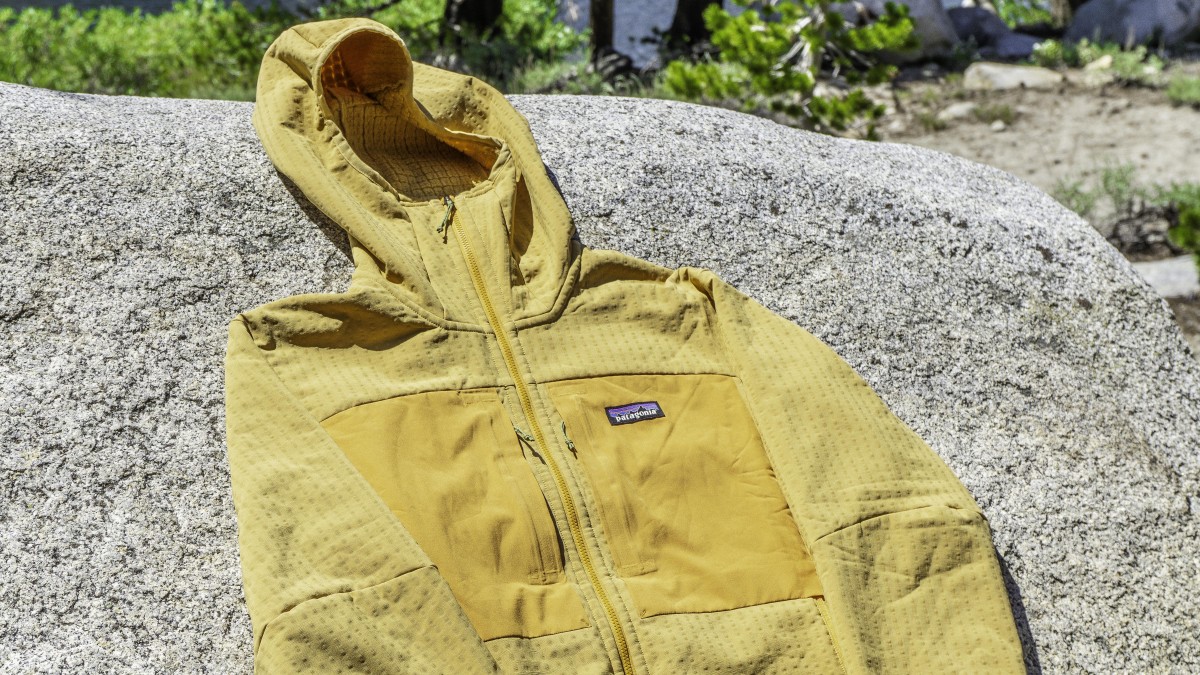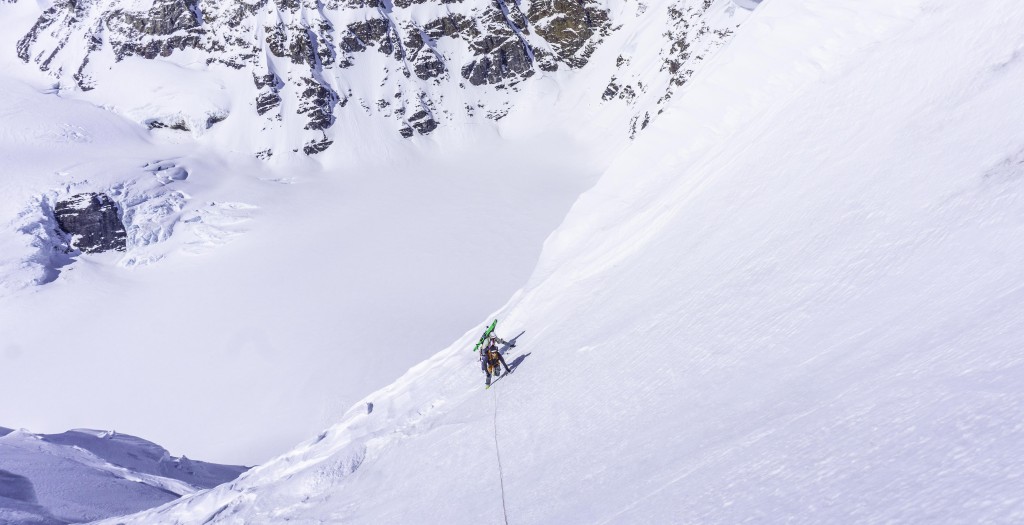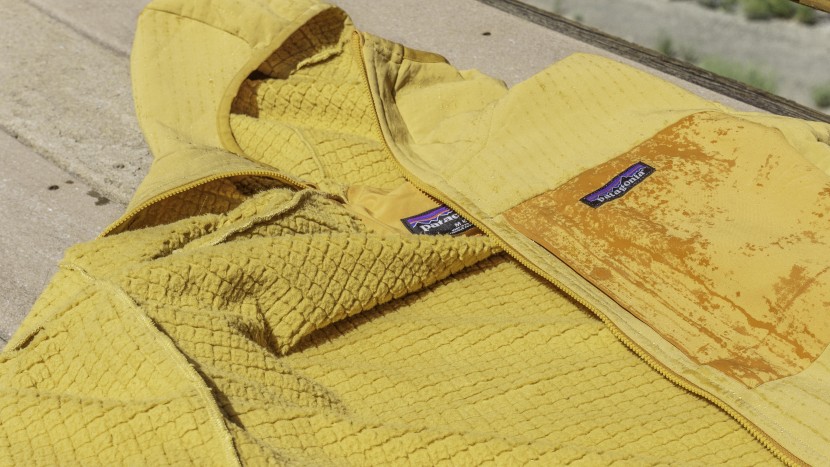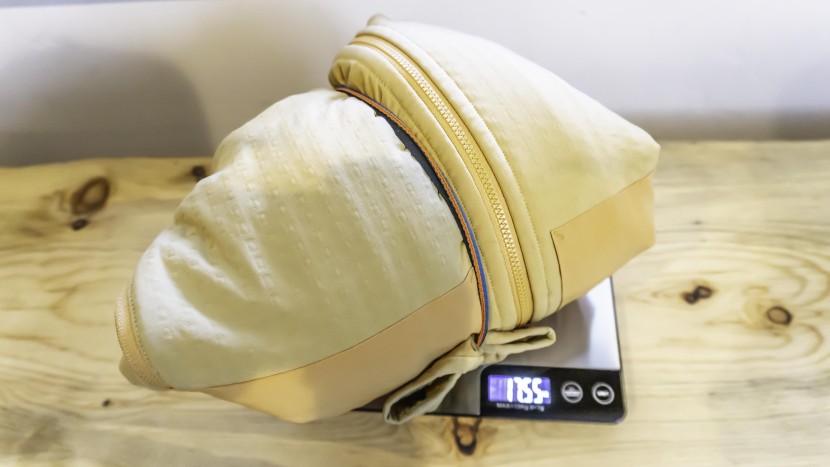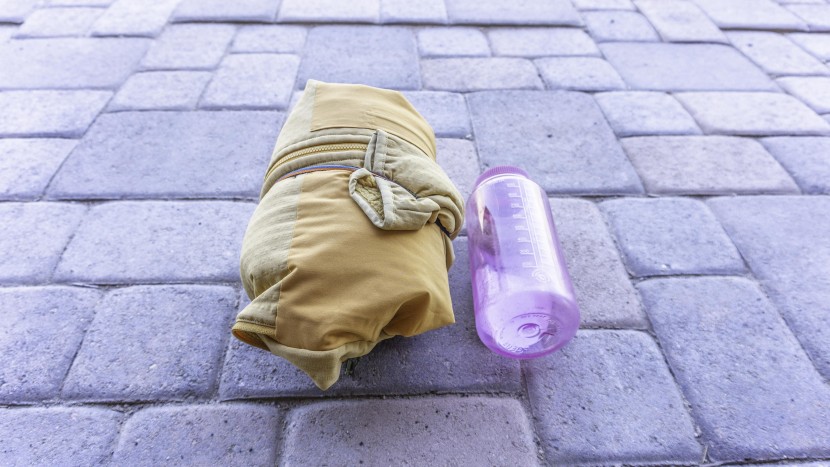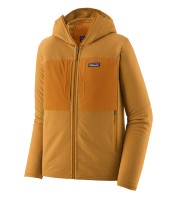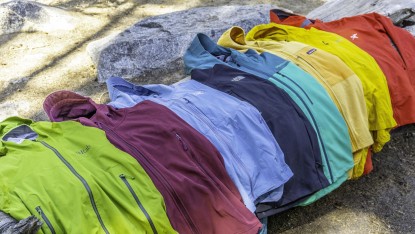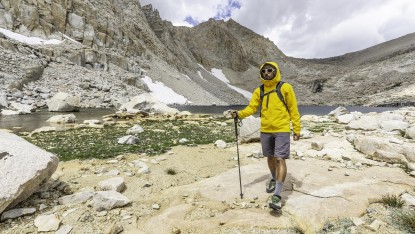
Our Verdict
Our Analysis and Test Results
The Patagonia R2 TechFace Hoody offers excellent value in a warm, weather-resistant package. While this wasn't our go-to on hotter days, this was a garment we loved when things got chilly and stormy.
Weather Protection
Weather protection is a crucial component of any shell, so we weighted this metric at 30% of the total score of the R2. We spent weeks with each jacket in the field, testing across varying climates and geographies and keeping detailed notes of our findings. Then, we began a series of objective tests. We stood under a full-blast shower for one minute before measuring the surface area of the wet spots of our underlayer. Next, we put a bottle with boiling water inside each jacket, recording the time it took for the water to go from boiling to below 170F. Lastly, we soaked a one-foot squared section of fabric and dried it with a hair dryer on its no-heat setting, recording the total time needed to fully dry the fabric. The R2 Techface was a top performer in this metric.
The most stand-out aspect of the R2 in this arena was its water resistance, only letting in 4 square inches of water in our shower test. In the field, the DWR coating continued to impress us, dependably keeping moisture out during brief afternoon thunderstorms. The exterior shell fabric of this layer, at first glance, didn't seem to be particularly weatherproof, but our results were conclusive.
For heat retention, this option did well with a 30-minute and 15-second time. This wasn't the top score, but considering its performance in other metrics, its warmth was in a decent middle ground: warm enough without sacrificing breathability. The largest setback with this option was the drying time. While it takes a lot of moisture to get the R2 soaked, the fleece inner takes a very long time to dry.
Breathability
Breathability is, arguably, the most important metric in a softshell jacket, so it's no surprise we assigned it 30% of the total score. We tested this metric with weeks of field testing, taking extensive notes along the way about how the R2 performed. Then, we took each layer on a 45-minute cardio session of similar intensity and ambient air temperatures. At the end of the cardio session, we measured the surface area of the sweat spots of our underlayer. While the R2 didn't come in first in this metric, it did extremely well when considering how much warmth it offers.
As with any cold-weather garment, the breathability of the R2 simply depends on the ambient air temperatures and the output of the activity. While climbing or hiking on chilly, high-elevation terrain in the Sierra, this option was perfect. On warmer days, this jacket didn't stay on for long.
Mobility
Mobility is worth 25% of the total score of the R2 Techface since softshells are classified as activewear, and that means wearers expect to move. We tested this metric with extensive real-world use, taking notes along the way. Then, we performed the same movements with each layer, noting any range of motion restrictions and measuring the amount of waist lift. We also took note of any extra fabric bunching, as that, too, can greatly impact the activities you want to take on in your softshell. The R2 came in near the top of the pack.
The relaxed fit of the R2 Techface naturally offered excellent scores in this metric. While the lack of adjustability in the hem, hood, or sleeves is a major consideration when selecting this garment above others, the elastic was effective for our testers' needs. The hood is designed to be worn under the helmet for sports like climbing, though its hood thickness made it slightly tighter at the ears. The R2 had approximately four inches of waist lift, but its longer torso length made this a non-issue in field use.
Weight
Weight can be a priority for many shoppers, so we gave it 10% of the total score of the R2. We simply weighed each jacket on the same scale, noting our findings. We also sized up each option's packability, though we didn't include that aspect in this metric's scoring. As a warmer layer, this jacket came in the middle of the pack.
At 17.5 ounces, this jacket is certainly not the lightest in the lineup, but when considering it offers a fleece lining, it might save you from bringing another layer on your outing. Also, the packability of this jacket wasn't the worst we saw, and many won't find it negatively impacts their plans with its bulk.
Versatility
Versatility is worth 5% of the total score of the R2 Techface. We investigated each option's potential uses, from how many sports it can be worn for to its seasonality. We also looked at the R2's potential for being worn over or under other layers. This option came in about average in the lineup.
As a cooler weather layer, this isn't the go-to garment for hot days outside. However, we were able to use the R2 in more temperate environments in the summer and far more freely for the other three seasons. Depending on how one chooses a size, it works well both near the base layer or as an overlayer, though with how comfy the fleece lining is, we were partial to keeping it closer to the skin.
Should You Buy the Patagonia R2 TechFace Hoody?
This class of layer often comes with a hefty price tag, depending on the manufacturer, and given the high-tech multi-layered fabrics and heavier-duty construction. Fortunately, the R2 carries your dollar far, with a relatively approachable MSRP and performance worthy of the higher price. The Patagonia R2 TechFace Hoody is an excellent option for those seeking a softshell when things get cold and stormy. Unlike some of the cold-weather competition, this jacket offers enough breathability for you to keep moving, reducing the chances you'll get soaked from the inside out.
What Other Softshell Jackets Should You Consider?
Take a look at the Arc'Teryx Gamma MX Hoody, which is a similar class of jacket to the Patagonia R2 TechFace Hoody as a weather-resistant, warmer softshell. If water resistance is a priority over warmth, take a look at the Rab Kinetic 2.0, which repels water in a lighter-weight package.
| Awards | Best for Cold Weather |
|---|---|
| Price | $229 List Check Price at Backcountry |
Overall Score  |
|
| Star Rating | |
| Bottom Line | A fleece-lined softshell that boasts excellent comfort and outperforms its weight class in breathability, making it a great garment in cooler environments |
| Pros | Top tier water-resistance, cozy next-to-skin comfort, Great breathability for its warmth |
| Cons | No fit adjustments, less athletic cut |
| Rating Categories | Patagonia R2 TechFac... |
| Weather Protection (30%) | |
| Breathability (30%) | |
| Mobility (25%) | |
| Weight (10%) | |
| Versatility (5%) | |
| Specifications | Patagonia R2 TechFac... |
| Fabric Weight Class | Heavyweight |
| Material | 7.9-oz 92% recycled polyester/8% spandex stretch double weave with DWR finish |
| Measured Weight (Size) | 17.5 oz (medium) |
| Number of Pockets | 2 exterior chest zip, 2 exterior hand zip, 2 interior drop-in |
| Insulated | Yes |
| Hood | Yes, under helmet with elastic binding |
| Unique Features | Fleece-lined inner, tailored under-helmet hood |
| Layering Capabilities | Can be layered over or under other layers |
| Adjustable Cuffs (Material) | No (fixed elastic cuffs) |
| Available Sizes | XS - 2XL |
| Breathability Test (In-Use Absorption) | 35 sq in |
| Warmth Test | 30.25 min |
| Water Retention Test (1-Min Soak) | 4 sq in |
| Drying Test | 36.17 min |


